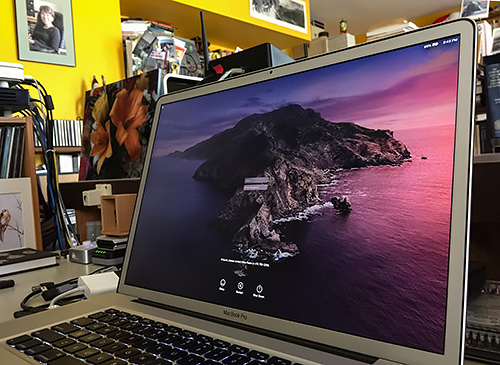Photo Corners headlinesarchivemikepasini.com
![]()
A S C R A P B O O K O F S O L U T I O N S F O R T H E P H O T O G R A P H E R
![]()
Enhancing the enjoyment of taking pictures with news that matters, features that entertain and images that delight. Published frequently.
Climbing onto Catalina



31 October 2021
We never expected to run macOS 10.15 Catalina on our 2010-era MacBook Pros. But here we are on the cusp of revolutionary new image processing hardware in the 2021 MacBook Pros running macOS Monterey with our hands in our pockets.

As others thrill at the advances in Monterey, we are taking in the Catalina experience for the first time. Of course, we don't have the compatibility issues stumping the Monterey crowd. They've all been resolved months and months ago.
WHERE WE ARE
A year ago, we moved to Mojave even though it wasn't supported on our hardware. But some excellent work by Collin the dosdude and his friends resulted in a compatible installer with patches for the old hardware.
And for a year that has worked without any problem. We'd even have to call it an improvement over High Sierra.
But Apple has stopped supporting Mojave period.
Now, Adobe Elements, DxO Lab and Photoshop have all set Catalina as the minimum supported macOS.
The last time this happened to us, we took the long view:
Our installation of High Sierra was just over a year ago. Our previous macOS runs were over two years for both Sierra and Yosemite. If we make it a year with our patched Mojave, the first professional ARM-based Macs should be available.
And right on schedule the 14-inch and 16-inch MacBook Pros with M1 Pro and M1 Max were announced.
We hope to unearth sufficient funds to acquire one to replace our 11-year-old workhorses, at least in part. Sometime in 2022.
Meanwhile and fortunately for us Collin has made available a Catalina installer for our machines for some time now.
We installed it on an external drive as a proof of concept to test Elements and do our recent DxO reviews. Even running over USB-A, it was quick on its feet and we only rebooted into Mojave to run the applications we didn't install on the external.
It does mean giving up our Wacom tablet and (once and for all) Spell Catcher. We will miss both very much.
Those are two reasons we stuck with Mojave, in fact.
CATALINA
The problem with Catalina is it has a terrible reputation among Mac users who do more than surf the Web and reply to email. You know, people who do productive work.
It doesn't help that Apple moved on to Big Sur (now just reaching maturity) and has just dumped Monterey on the world. Fortunately, it is still supporting Catalina. As of this week anyway.
None of these releases provides any significant productivity advance over its predecessors but they all cost users a good deal.
One large concern of ours was moving to a hard disk format that invisibly separates the storage into protected and unprotected areas. That hasn't proved to be a problem, though, despite Mojave mounting two disks, one for each area, on the Desktop.
The other concern was the loss of 32-bit applications like Spell Catcher. Evan Goss, the author, passed away before 64-bit software a gleam in Apple's eye. So there's no hope of reviving that. And there really isn't an equivalent for spell checking a document (Apple's approach is just not up to snuff).
But it's been some time since Catalina was released and active applications have all been updated.
It's more a question now of do we want to hang on to old releases as new ones come out? No, we don't.
THE INSTALL
So we bit the bullet and first installed Catalina on the 13-inch MacBook Pro we rely on when we travel. We wanted to make sure our essential suite would function.
Collin's Catalina installer provides a much smoother experience than the Mojave installer. So we got a boot right away.
But there are still Adobe downloads to install before we can kick the tires and convince ourselves to install Catalina on our main production box, a 17-inch MacBook Pro from 2010.
We took a few days to run through our checklist that reminds us to enable PHP, check Apache and MySQL, confirm ExifTool is running, as well as ImageMagick. And go through our suite of production software.
THE VERDICT
When we realized we could survive on macOS's built-in spell checking (we used it to spell check this story) and that even though the new Photoshop v23 won't launch the prior v22 works fine (we used it for the photo accompanying this article), we decided to make the leap.
We did have some PHP code to update and a big update to MySQL 8, but we proved that would work on the travel laptop already.
So on Halloween no less, we made the leap to Catalina. This is the first piece we've produced on it. And if our fans hold out, we'll archive the month with it shortly.
CONCLUSION
It's remarkable that we've been able to run the same hardware for 10 years. It reduced our costs to about $250 a year for the 17-inch laptop and under $100 a year for the 13-inch model. That's $30 a month for hardware.
The idea of spending $2,600 for two years of production is insane to us. Even buying a new iPhone every two years is beyond extravagant. You can do better things with money.
But before 2022 ends, we hope to be running Monterey on an M1 as our main production box and keeping an eye on Apple's refurb store to pick up a backup unit a few months after that.
Meanwhile, thanks to Collin the Dosdude, we'll run Catalina and like it.